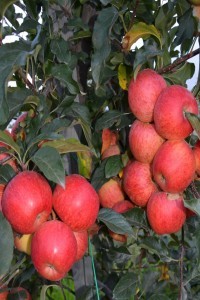Effect of pollinator cultivars on nutrient content in some Turkish hazelnut cultivars
Effect of pollinator cultivars on nutrient content in some Turkish hazelnut cultivars
The main objective of this study was to assess the pollen effects on macro and micro nutrition elements on hazelnut cultivars (Corylus avellana L.). Tombul, Palaz, Çakıldak, Foşa and Allahverdi were used as main cultivars while Tombul, Palaz, Çakıldak, Foşa, Allahverdi, Sivri, Kalınkara and Yassı Badem were used as pollinator cultivars. In the study, it was investigated that the pollinator cultivars caused changes in some nutrition elements. The effects of the applications on nitrogen, phosphorus and potassium content were found to be statistically significant. It was determined that the nutrition element with the highest rate in the examined hazelnut cultivars is potassium. It has been observed that the amount of potassium is high in Tombul-pollinator treatments. The potassium content of Foşa and Çakıldak weres found to be higher than other cultivars. In Palaz and Yassı Badem-pollination treatments, it has been observed that the Ca content is generally lower than other treatments. Fe content was found to be significantly higher in Palaz-pollination treatments. The highest Mn and Zn content was obtained from Çakıldak. As a result, it has been revealed that pollinators may have an effect on nutrient content.
Keywords:
Corylus avellana L., mineral elements, pollen xenia, quality,
___
- Ak, B. E. (2001). Effects of different pistacia species pollen on fruit dimension and weight in the ‘Kırmızı’ variety. Cahiers OPTIONS Méditerranéennes, 56, 311-315.
- Alhajjar, N. M., Muzher, B. M. & Hamed, F. (2015). The effcet of pollen grains Pistacia vera and Pistacia atlantica (unisexual and hermaphrodite) on quality parameters of ashoury and batoury pistachio cultivars. Jordan Journal of Agricultural Sciences, 11, 15-24.
- Amaral, J. S., Casal, S., Citová, I., Santos, A., Seabra, R. M., & Oliveira, B. P. (2006). Characterization of several hazelnut (Corylus avellana L.) cultivars based in chemical, fatty acid and sterol composition. European Food Research and Technology, 222(3), 274-280.
- Anonymous. (2021). General Secretariat of Black Sea Exporters Association. http://www.kib.org.tr/files/downloads/20182019.pdf. (accessed to web: 29 March, 2021).
- AOAC, (2000). Official methods of analysis of AOAC international. 17th ed. Gaithersburg (MD): AOAC International.
- Balik, H. İ., & Beyhan, N. (2019). Pollen compatibility in Turkish hazelnut cultivars. Turkish Journal of Food and Agriculture Sciences, 1(1), 12-17.
- Balik, H. İ., & Beyhan, N. (2020). Xenia and metaxenia affects bioactive compounds of hazelnut. Turkish Journal of Food and Agriculture Sciences, 2(2), 42-49.
- Cristofori, V., Ferramondo, S., Bertazza, G., & Bignami, C. (2008). Nut and kernel traits and chemical composition of hazelnut (Corylus avellana L.) cultivars. Journal of the Science of Food and Agriculture, 88(6), 1091-1098.
- Denney, J. O., (1992). Xenia includes metaxenia. Hortscience, 27(7), 722-728.
- Dicenta, F., Ortega, E., Canovas, J. A., & Egea, J. (2002). Self‐pollination vs. cross‐pollination in almond: pollen tube growth, fruit set and fruit characteristics. Plant Breeding, 121(2), 163-167.
- Erdogan, V., & Mehlenbacher, S. A. (1997). Preliminary results on interspecific hybridization in Corylus. In IV International Symposium on Hazelnut 445 (pp. 65-72).
- FAO. (2021). Plant Production Statistics. http://www.fao.org/faostat/en/#data/QC. (accessed to web: 29 March, 2021)
- Fattahi, R., Mohammadzedeh, M., & Khadivi-Khub, A. (2014). Influence of different pollen sources on nut and kernel characteristics of hazelnut. Scientia Horticulturae, 173, 15-19.
- Golzari, M., Hassani, D., Rahemi, M. & Vahdati, K. (2016). Xenia and metaxenia in Persian walnut (Juglans regia L.). Journal of Nuts, 7(2), 101-108.
- Köksal, A. İ., Artik, N., Şimşek, A., & Güneş, N. (2006). Nutrient composition of hazelnut (Corylus avellana L.) varieties cultivated in Turkey. Food Chemistry, 99(3), 509-515.
- Legave, J. M., Richard, J. C., Thermoz, J. P., & Duval, H. (1997). Amandier: Lauranne, avijor dans la course. Réussir Fruits et Légumes, 155, 36-38.
- Özenç, N., Bender Özenç, D., & Duyar, Ö. (2014). Nutritional composition of hazelnut (Corylus avellana L.) as influenced by basic fertilization. Acta Agriculturae Scandinavica, Section B—Soil & Plant Science, 64(8), 710-721.
- Samur, G. (2008). Anne sütü. Sağlık Bakanlığı Yayınları, Ankara, 1-21.
- Şimşek, A. & Aslantaş, R. (1999). Fındığın bileşimi ve insan beslenmesi açısından önemi. Gıda, 24(3), 209-216.
- Şimşek, A. (2004). Değişik kavurma proseslerinin bazı fındık çeşitlerinde oluşturduğu biyokimyasal değişiklikler. Doktora Tezi, Ankara Üniversitesi Fen Bilimleri Enstitüsü Gıda Mühendisliği Anabilim Dalı, 165, Ankara.
- Torregrossa, J. P., Vaissière, B., Rodet, G., Botella, L., & Cousin, M. (1993). Besoins en pollinisation de la variete d'amandier autocompatible Lauranne. Apidologie, 24(4), 443-445.
- Yayın Aralığı: Yılda 2 Sayı
- Başlangıç: 2019
- Yayıncı: Burhan ÖZTÜRK
Sayıdaki Diğer Makaleler
Effect of land configuration ways on soil moisture and sesame seed yield in Ethiopia
Goitom TEAME, Alemtsehay TSEGAY, Dawit WELDEAREAGY
Effect of pollinator cultivars on nutrient content in some Turkish hazelnut cultivars
Hüseyin İrfan BALIK, Neriman BEYHAN
